
Juniperus sabina, the savin juniper or savin, is a species of juniper native to the mountains of central and southern Europe and western and central Asia, from Spain to eastern Siberia, typically growing at altitudes of 1,000–3,300 metres.
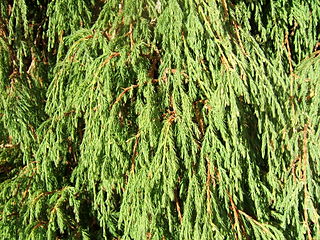
Juniperus recurva, commonly named the Himalayan juniper or drooping juniper, is a juniper native to the Himalaya, from northern Pakistan, through India, Nepal and Bhutan, to western Yunnan in southwestern China. It grows at altitudes of 3,000–4,000 metres.

Juniperus flaccida is a large shrub or small tree reaching 5–10 metres tall. It is native to central and northern Mexico and the extreme southwest of Texas, United States. It grows at moderate altitudes of 800–2,600 metres, on dry soils.

Metrosideros collina is a species of flowering plant in the family Myrtaceae. It is native to French Polynesia and the Cook Islands.
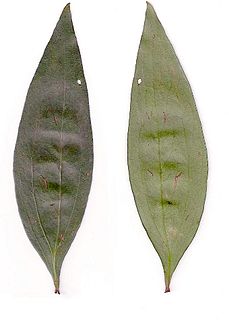
Stenocarpus salignus, known as the scrub beefwood is an Australian rainforest tree in the family Proteaceae. Found in warmer rainforests on the coast and ranges. It is often found in warm temperate rainforest on poorer sedimentary soils, or on volcanic soils above 750 metres above sea level. It was originally described by the botanist Robert Brown in 1810.

Dendrobium bigibbum, commonly known as the Cooktown orchid or mauve butterfly orchid, is an epiphytic or lithophytic orchid in the family Orchidaceae. It has cylindrical pseudobulbs, each with between three and five green or purplish leaves and arching flowering stems with up to twenty, usually lilac-purple flowers. It occurs in tropical North Queensland, Australia and New Guinea.
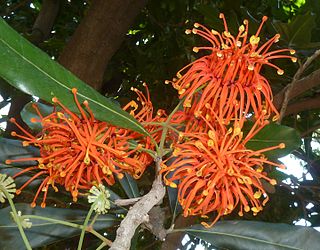
Stenocarpus sinuatus, known as the firewheel tree, is an Australian rainforest tree in the family Proteaceae. The range of natural distribution is in various rainforest types from the Nambucca River in New South Wales to the Atherton Tableland in tropical Queensland. Stenocarpus sinuatus is widely planted as an ornamental tree in other parts of Australia and in different parts of the world.

Stenocarpus cryptocarpus, commonly known as the giant-leaved stenocarpus, is a species of flowering plant in the family Proteaceae and is endemic to north Queensland. It is a tree with buttress roots at the base, simple, mostly elliptical adult leaves, groups of cream-coloured flowers and narrow oblong follicles.

Metrosideros operculata is a species of flowering plant in the family Myrtaceae. It is endemic to New Caledonia. It usually grows as a shrub to 3 metres in height, or rarely as a small tree to 10 metres. Stems are square in section and covered with silky hairs. The stiff, pointed leaves have a slightly revolute margin and are linear to elliptic in shape. They are 12 to 40 mm long and 3 to 10 mm wide. White, pink or red flowers with 3 petals and between 50 and 120 stamens are produced in axillary inflorescences.
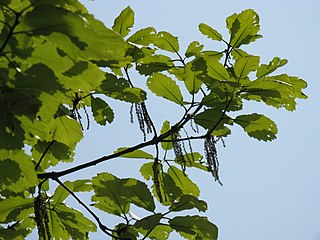
Quercus aliena, the galcham oak or oriental white oak, is a species of oak in the family Fagaceae, in the white oak section Quercus.

Acronychia laevis, commonly known as hard aspen, glossy acronychia or northern white lilly pilly, is a species of shrub or small tree in the citrus family, and is endemic to eastern Australia. It has simple, elliptical to egg-shaped leaves, groups of creamy white flowers and fleshy, mitre-shaped to spherical fruit.

Pseudotsuga menziesii var. menziesii, commonly known as Coast Douglas-fir, Pacific Douglas-fir, Oregon pine, or Douglas spruce, is an evergreen conifer native to western North America from west-central British Columbia, Canada southward to central California, United States. In Oregon and Washington its range is continuous from the Cascades crest west to the Pacific Coast Ranges and Pacific Ocean. In California, it is found in the Klamath and California Coast Ranges as far south as the Santa Lucia Mountains with a small stand as far south as the Purisima Hills, Santa Barbara County. In the Sierra Nevada it ranges as far south as the Yosemite region. It occurs from near sea level along the coast to 1,800 metres (5,900 ft) in the California Mountains. Further inland, coast Douglas-fir is replaced by Rocky Mountain or interior Douglas-fir. Interior Douglas-fir intergrades with coast Douglas-fir in the Cascades of northern Washington and southern British Columbia.

Balanophora fungosa, sometimes known as fungus root is a flowering plant in the family Balanophoraceae and occurs in South Asia, Southeast Asia, Australia and some Pacific Islands. It is an obligate parasite growing on the roots of rainforest trees. The flowering structure is shaped like a puffball but in fact consists of a globe covered with thousands of tiny female flowers. The globe is surrounded at its base by a much smaller number of male flowers. In flower, the plant emits an odour resembling that of mice.

Zanthoxylum pinnatum, commonly known as yellow wood, is a species of flowering plant of the family Rutaceae native to Lord Howe and Norfolk Islands. It is a tree with pinnate leaves, white male and female flowers arranged in groups in leaf axils, and spherical, purple follicles containing a single black seed.
Stenocarpus acacioides is a species of flowering plant in the family Proteaceae and is endemic to north-western Australia. It is a shrub or tree with elliptic leaves and groups of white flowers and woody, linear follicles.

Stenocarpus angustifolius is a species of flowering plant in the family Proteaceae and is endemic to Queensland. It is a shrub or small tree with narrow lance-shaped adult leaves, groups of creamy white flowers and cylindrical follicles.
Stenocarpus verticis is a species of flowering plant in the family Proteaceae and is endemic to northern Australia. It is a tree with elliptic or lance-shaped adult leaves and groups of cream-coloured flowers covered with woolly, rust-coloured or grey hairs.

Stenocarpus cunninghamii, commonly known as little wheel bush, is a species of flowering plant in the family Proteaceae and is endemic to northern Australia. It is a shrub or small tree with simple, narrow elliptic or lance-shaped adult leaves, groups of pale yellow or white flowers and woody, linear follicles.
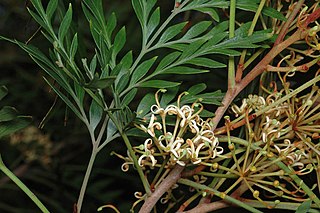
Stenocarpus davallioides, commonly known as the fern-leaved stenocarpus, is a species of flowering plant in the family Proteaceae and is endemic to north Queensland. It is a tree with simple or pinnate adult leaves, groups of creamy-green flowers and narrow oblong follicles.
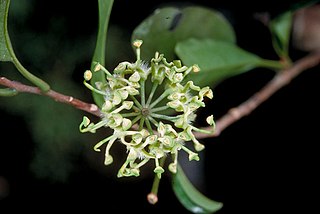
Stenocarpus reticulatus, commonly known as black silky oak, is a species of flowering plant in the family Proteaceae and is endemic to north Queensland. It is a tree with simple leaves, groups of strongly-perfumed, creamy-white flowers and flattened, semi-circular follicles.


















